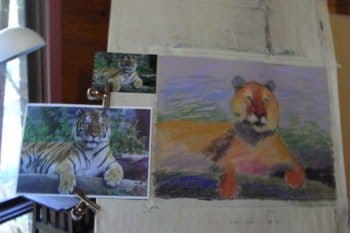Everything you need to start Pastel Painting
Pastel Art Tutorials
Everything you need to start Pastel Painting

Surprisingly enough, you don’t actually need a lot of things to get started in pastels. Most important of course, are the pastels themselves.
Welcome to part 2 of our 10 part Painting with Pastels Course, where we teach you the steps to take, so that you can produce beautiful pastel paintings.
Today we will introduce you to the things you are going to need in order to begin.
All of the big brands of pastel makers sell their pastel sticks in sets as well as individually. While some people advocate buying sticks individually, starting with say 10 sticks and then building up to 30 or 40, there is something to be said for letting the pastel maker do the work of selecting the most useful colours and simply buying a set.
Your first pastel sticks should be soft pastels, specifically a medium-soft grade.
If you can, it’s a good idea to ‘try before you buy.’ A lot of art supply shops will present you with a few pastels for this reason.
You probably won’t be able to try all the colours but you should be able to test a few different brands, get a feel for their texture and find out which ones you like.
In the book ‘Pastel Painting Secrets’ there is a review of several different brands, the majority of which the author has used herself.
Click here to visit the page.
And here is a list of colours to consider:
- Cold Red
- Warm Red
- Orange
- Cold Yellow
- Cold Green
- Warm Green
- Cold Blue
- Warm Blue
- Cold Violet
- Warm Violet
- Black and White
This will give you a set of 12 colours and you should be able to produce some great artwork from this palate.
Once you have your pastels, the next thing you will need is a surface to work on, and paper is the obvious choice. When you are starting out it is great to have some practice paper on hand as well.
There are several different types of art paper available, including paper specifically manufactured for pastels.
The next thing you will need is a drawing board. A drawing board is simply a rigid surface that you clip your paper to. It can be then mounted on an easel, spread on a table or simply rested on your knees.
The pastels themselves, some paper and a drawing board, these are all the tools you need to get started painting with pastels.
By the same token there is a complete ‘shopping list’ in each of the ‘Step by Step’ books.
Click here for more info.
As you progress you may want to get a proper easel, and you’ll definitely want to consider some tools for blending and for correcting, but there’s no reason you can’t get these as and when you need them.
In the next module, we will look at the different types of pastels.
